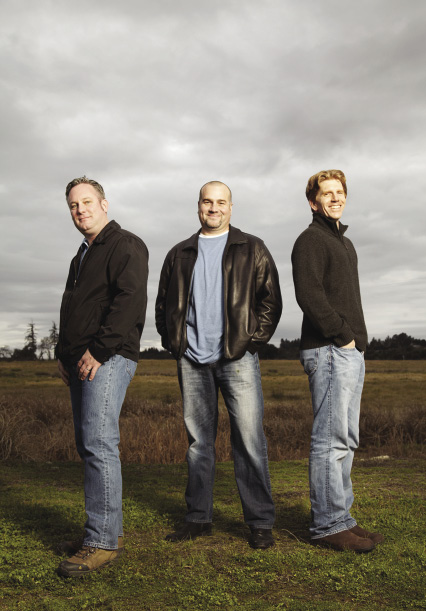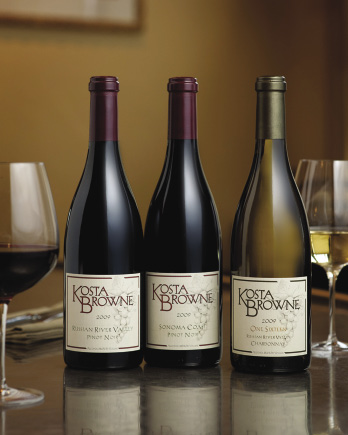- Home
- Media Kit
- Current Issue
- Past Issues
- Ad Specs-Submission
- Ad Print Settings
- Reprints (PDF)
- Photo Specifications (PDF)
- Contact Us

![]()
ONLINE


Kosta Browne founders Michael Browne (left)
and Dan Kosta (center), with partner Chris Costello (right)
Complex, Intense, and Balanced
Editors’ Note
Dan Kosta began his fine-dining career working for John Ash & Co. restaurant in Santa Rosa, California, and eventually became the restaurant’s Operations Manager and Wine Director. Kosta has also consulted for numerous restaurants in California’s Sonoma County and has sat on the boards of directors for the Sonoma County Harvest Fair, Sonoma County Vintners, and the Sonoma County Tourism Bureau, and participates as a judge for the San Francisco Chronicle Wine Competition, West Coast Wine Competition, and Grand Harvest Awards.
Company Brief
Founded in 1997 by Dan Kosta and Michael Browne, Sebastopol, California-based Kosta Browne Winery (www.kostabrowne.com) produces multiple Pinot Noirs under three appellations – Sonoma Coast, Russian River Valley, and Santa Lucia Highlands, as well as a Russian River Valley Chardonnay.
Has the brand evolved the way you had hoped?
Absolutely. We were realistic about it. We wanted to make wine that we would want to drink and we got lucky that so many people enjoyed the style we made for ourselves.
Pinot Noir is a crowded market, but Kosta Browne has a unique style. How do you define that style?
Michael Browne likes to call it “making a delicious beverage.” We didn’t set out to create a certain style of Pinot Noir; we set out to make a Pinot Noir that was more expressive of California Pinot Noirs at the time. We loved it but we felt there was so much more potential in it, and at day’s end, that means more complexity and more intensity in a lot of cases, as well as more of that yummy factor.
Pinot Noir is an elegant, complex grape and we wanted to bring the most out of it. A lot of people think we make big, ripe Pinot Noirs – sometimes that comes from what the vineyard is giving us and sometimes, that comes from how we get the most complexity out of the vintage.
We consider ourselves a medium- to full-bodied Pinot Noir, but more importantly, we strive to craft a complex, intense, and balanced Pinot Noir that maintains an elegant sensibility from the grape.

How effective has your distribution focus been?
The goal of most wineries is to sell as much wine as you can directly to your customer without having a lot of middle men or three-tier distribution, and that has been our goal.
It also depends on your ability to market the wine and the quality of the wine itself, which drives overall demand.
The way we drove demand towards our mailing list was through the three-tier system at the beginning – getting people exposed to the wines through restaurants, wine lists, and venues where a sommelier acted as an ambassador for the brand to tell our story.
Traditional distribution has its role, but at day’s end, we wanted to have that direct-to-consumer relationship so we understood exactly where the wines were going and how it was being consumed.
Have you considered growing your distribution?
We’re about 90 percent direct-to-consumer, 10 percent traditional three-tier distribution.
In terms of increasing production and therefore sales, it depends on the quality of vineyards that allow you to grow with quality in mind rather than going out and creating a lot of Pinot Noir. The wine is very sensitive in that it doesn’t want to be made in these very large lots. We specialize in small lot Pinot Noirs that are representative of specific vineyards and that is tough to scale.
It’s a matter of how much quality allows us to grow, and it’s allowing us to grow slowly. So we’re going to grow organically without pushing it out just to satisfy a demand. This has allowed us to build a rather sizeable waiting list.
In producing wine, at what stage do you know how the release will turn out?
You can get a good idea if you pay attention to what type of growing season it was in terms of rain and temperature or by vigor of a certain vineyard.
The first time you get a chance to see how good the vintage will be is when you start tasting the fruit before harvest; that way, you know the true complexities of that vintage.
For us, it comes down to flavor. When you’re out there getting dirty in the vineyards, you know what kind of vintage it’s going to be.
With such high demand, why have you not raised prices?
The balance is value, which doesn’t necessarily mean I’m getting a great deal – it means I’m getting what I pay for.
Theoretically, we could probably raise our prices to $150 and sell out the vintage, but it’s not necessarily about this vintage; it’s about the next vintage. It’s doing the right thing, offering value and good will.
So we strike a balance that is somewhat arbitrary.
Is it important for customers to understand the subtle differences in your products?
It’s important, and the reason we have all these single vineyard designates is because those vineyards are extremely expressive and unique, and continuously produce a certain level of quality.
It’s our job to get that profile across to our customers, which we do by offering those wines year after year – we don’t experiment too much with new vineyards because we want people to know what to expect.
The other important part of that is telling the story of the vineyard, and that is usually telling the story of the winegrower himself – those stories are extremely important and those guys put a lot of energy into their fruit, which is translated into the wine.
Do advances in technology change the way you produce wines?
It does change the process, but it makes it better. If we have a sorting table that enables us to take out unwanted grapes more efficiently, thereby making the wine better, that is a technological advance.
Also, the new press we bought two years ago has added to the quality of the wines. In addition, analysis in the lab is not making the wine homogenized but it’s allowing us to laser in on the true character of a specific wine.
Have there been opportunities to broaden into other categories?
The Pinot Noir has created our brand and our image, but we are in our second year of making Chardonnay, which is a natural fit, because the Chardonnay vineyards that we source from are next door to some of our best Pinot Noir vineyards in the Russian River Valley.
It’s always enticing to do other things as far as other varietals, but we never want to be all things to all people. Our quest is not done. Our team at Kosta Browne continues to be motivated to produce the finest wines possible, while over delivering on the service our customers have come to expect from us.•